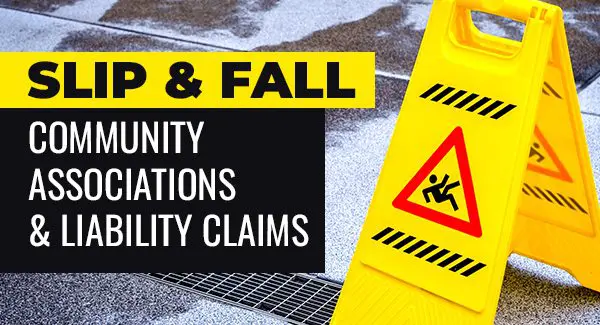- Community Associations, Insurance, Litigation, Seasonal and Holidays
- Wisconsin, Indiana, Illinois, Florida
Condominium, homeowner (HOA), and townhome community associations have a responsibility to maintain common areas according to their governing documents. However, accidents can happen. Slip, trip, and fall claims are among the most common liability issues associations face. These claims can lead to costly litigation, increased insurance premiums, and potential financial strain on the community.
By understanding the risks associated with premises liability claims and proactively employing strategic insurance defense measures, board members can work to safeguard their communities from unnecessary legal and financial burdens.
Common Premises Liability Claims in Community Associations
Premises liability claims arise when a person is injured due to an alleged hazardous condition on the association’s property. The most frequent claims include:
- Slip-and-Fall on Wet or Icy Walkways– Poorly maintained sidewalks, entryways, or parking lots can become hazardous, especially in inclement weather. For example, Illinois law recognizes that “. . . it is unrealistic to expect property owners to keep all areas where people may walk clear from ice and snow at all times during the winter months.’ ” Allen v. Cam Girls, LLC, 2017 IL App (1st) 163340. However many associations engage professional services to remove snow and ice as a benefit to homeowners. This undertaking also comes with responsibilities to ensure snow and ice removal is performed to an appropriate standard.
- Trip-and-Fall on Uneven Surfaces– Cracked pavement, loose tiles, or uneven stairs can create tripping hazards that lead to injury claims. Pool areas are also a common concern, as wet surfaces combined with uneven decking or loose tiles can increase the risk of falls. Associations should perform routine maintenance and necessary inspection of pool decks to identify and repair any possible hazards.
- Poor Lighting and Visibility Issues– Insufficient lighting in hallways, stairwells, or parking garages can contribute to accidents.
- Negligent Maintenance of Common Areas– Broken handrails, loose carpeting, and other maintenance issues in common areas (ex. clubhouses, pools) or other shared spaces can lead to liability claims.
Understanding Common Areas vs. Limited Common Areas When evaluating premises liability risks, it’s important for board members, property managers, and community leaders to distinguish between common areas and limited common areas. Each may carry different maintenance responsibilities and liability considerations.
- Common Areas– These are shared spaces that all residents have access to including sidewalks, parking lots, clubhouses, pools, and playgrounds. The association is generally responsible for maintaining these areas and ensuring they are in reasonably safe conditions for its invitees.
- Limited Common Areas– These are areas designated for the use of specific units or residents. Examples could include balconies, patios, stairwells serving specific units, and assigned parking spaces. Responsibility for maintenance and liability in these areas can vary based on the association’s governing documents.
Because liability often hinges on maintenance responsibilities, associations must review their governing documents (declaration, bylaws, and rules and regulations) to clearly define areas they are obligated to maintain and repair. These documents outline whether the association or the individual unit owner is responsible for upkeep that can directly impact liability in the event of a slip and fall claim.
How Insurance Helps Mitigate Risks and Costs
When a premises liability claim is filed against a community association, insurance defense strategies can help reduce legal costs, minimize financial exposure, and prevent fraudulent or exaggerated claims.
Liability Coverage and Legal Defense – Most community associations carry general liability insurance which provides coverage for bodily injury claims occurring on association property. When a claim is filed, the insurance carrier will typically assign an attorney to defend the association. This legal representation is critical in assessing the validity of the claim, gathering evidence, and, if necessary, fighting the case in court.
Investigation and Documentation – One of the first steps in an insurance defense strategy is a thorough investigation of the incident. This includes:
- Reviewing video footage
- Inspecting and documenting the alleged hazard
- Examining maintenance and repair records
Proper documentation can help disprove claims or demonstrate that the association took reasonable steps to maintain the premises according to the responsibilities outlined in the governing documents.
Comparative Negligence Defense – Many states follow comparative negligence laws, which allow liability to be shared between the injured party and the association. For example, if a resident was texting and not paying attention while walking on an icy sidewalk, the defense could argue that they were partially responsible for their fall. This could reduce or eliminate the association’s liability.
Preventing Fraudulent Claims – Unfortunately, some claims may be exaggerated or entirely fraudulent. Insurance defense teams often work with investigators to verify claims. In cases of suspected fraud, surveillance footage, medical record reviews, and even social media activity may be examined to challenge the legitimacy of a claim.
Best Practices to Reduce Premises Liability Risks
While insurance defense is essential, proactive risk management can help reduce the likelihood of slip, trip, and fall claims in the first place. Here are some best practices:
- Routine Maintenance and Inspections – Conduct regular maintenance checks of walkways, stairwells, and common areas. Repair hazards promptly.
- Snow and Ice Removal Plans – Have a plan in place for winter weather hazards, including timely salting and shoveling. Also, clearly and routinely communicate homeowner responsibilities regarding salting of driveways and walkways.
- Proper Lighting and Signage – Ensure all common areas are well-lit.
- Incident Reporting Protocols – Require residents and employees to document accidents immediately with photos and written reports.
- Legal Counsel – Work with the association’s attorney to ensure proper insurance coverage aligns with relevant laws and maintenance responsibilities are outlined in the community’s governing documents.
- Review Insurance Policies – Work with an insurance professional to ensure the association’s liability coverage is adequate.
Legal Resource Premises liability claims are an unavoidable risk for community associations. However, proactive risk management, having proper liability coverage, and taking steps to maintain common areas can mitigate potential risks.
Additionally, work with experienced legal counsel that is familiar with the nuances of community association law. They can play a critical role on your association’s professional team in developing and navigating insurance defense strategies.
Do not hesitate to contact our law firm if your association has questions about community association liability, insurance defense, litigation, or the legal process, or other legal concerns.
Please call 855-537-0500 or visit www.ksnlaw.com.
Since 1983, KSN has been a legal resource for condominium, homeowner, and townhome associations. Additionally, we represent clients in real estate transactions, collections, landlord/tenant issues, and property tax appeals. We represent thousands of clients and community associations throughout the US with offices in several states including Florida, Illinois, Indiana, and Wisconsin.
Please note the material contained in this article is for educational and informational purposes only and does not constitute legal advice. No attorney-client relationship is established by your review or receipt of the information contained in this article. You should not act on the information discussed in this article without first obtaining legal advice from an attorney duly licensed to practice law in your State. While KSN has made every effort to include up-to-date information in this article, the law can change quickly. Accordingly, please understand that information discussed in this article may not yet reflect the most recent legal developments. Material is not guaranteed to be correct, complete, or up to date. KSN reserves the right to revise or update the information and statements of law discussed in the article at any time, without notice, and disclaims any liability for your use of information or statements of law discussed on the article, or the accessibility of the article generally. This article may be considered advertising in some jurisdictions under applicable law/s and/or ethical rules/regulations. © 2025 Kovitz Shifrin Nesbit, A Professional Corporation.


